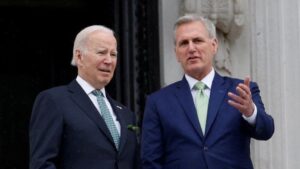
In May 2023, President Joe Biden and US House of Representatives Speaker Kevin McCarthy agreed to raise the US debt ceiling that could avert a cataclysmic default. The agreement moved the United States one step back from the brink of a historic default. This is not the first time the United States was playing with fire. The history of the debt ceiling is very interesting and so I decided to write about it in detail.
The debt ceiling is a limit imposed by Congress on the maximum amount of outstanding debt the U.S. can incur. It was first established in 1917 to give the Treasury autonomy over-borrowing by allowing it to issue debt up to the ceiling without congressional approval, making it easier to finance mobilization efforts in World War I.
Since 1960, Congress has raised, extended, or revised the debt limit 78 separate times. There have been several recent events related to the debt ceiling. For example, in May 2023, the Biden Administration was locked in a standoff with congressional Republicans over raising the federal debt ceiling just two weeks before the nation was set to default on its obligations for the first time.
The deal under consideration between President Joe Biden and House Republican Speaker Kevin McCarthy would lift the debt ceiling in exchange for holding non-defense discretionary spending around current year levels. The U.S. government will spend $936 billion on non-defense discretionary spending in 2023, the Office of Management and Budget estimates
The deal under consideration could boost defense spending to around $885 billion, in line with Biden’s 2024 budget spending proposal. That’s an 11% increase from the $800 billion allocated in the current budget.
Biden and McCarthy are expected to agree to claw back unused COVID relief funds as part of the budget deal, including funding that had been set aside for vaccine research and disaster relief.
But the fight on this is way more interesting if we started going back in time.
During Donald Trump‘s presidency, the debt ceiling was raised three times. The first time was in March 2017, when Congress passed a bill to raise the ceiling by $1.5 trillion. The second time was in September 2017, when Congress passed a bill to raise the ceiling by $400 billion. The third and final time was in December 2019, when Congress passed a bill to raise the ceiling by $2.2 trillion.
In each of the three times that the debt ceiling was raised during Trump’s presidency, there was a great deal of political debate about whether or not to do so. Republicans, who controlled both the House of Representatives and the Senate for most of Trump’s presidency, argued that raising the debt ceiling would only allow the government to continue spending money that it did not have. Democrats, on the other hand, argued that raising the debt ceiling was necessary to avoid a government shutdown and to ensure that the government could continue to pay its bills.
The 2018 debt ceiling and government shutdown was a political standoff that occurred in the United States between December 22, 2018, and January 25, 2019. The standoff was caused by a disagreement between the Republican-controlled Congress and the Democratic-controlled House of Representatives over whether to raise the debt ceiling.
In the 2018 debt ceiling standoff, Republicans argued that they would not raise the debt ceiling unless Democrats agreed to concessions on other issues, such as border security. Democrats, on the other hand, argued that raising the debt ceiling was a non-negotiable issue and that Republicans were holding the government hostage to get their way on other issues.
The standoff lasted for 35 days, the longest government shutdown in American history. During the shutdown, hundreds of thousands of federal employees were furloughed and many government services were suspended. The shutdown also hurt the economy, as businesses lost revenue and consumers cut back on spending.
In the end, Congress passed a bill to raise the debt ceiling, but only after Democrats agreed to some concessions on border security. The shutdown ended on January 25, 2019, and the government was able to resume normal operations.
The 2018 debt ceiling standoff was a major political event that had a significant impact on the United States. The shutdown showed the deep divisions in American politics and the difficulty of resolving even the most basic issues. The shutdown also harmed the economy, and it is likely to have long-term consequences for the country.
But way more interesting is what happened during Barack Obama’s time.
The debt ceiling crisis occurred during Obama’s presidency in 2011 and 2013. In 2011, the Republican Party, which gained control of the House of Representatives in January 2011, demanded that President Obama negotiate over deficit reduction in exchange for an increase in the debt ceiling. The crisis led to the passage of the Budget Control Act of 2011. The crisis did not permanently resolve the potential for future use of the debt ceiling in budgetary disputes, as shown by the subsequent crisis in 2013.
During the 2011 debt ceiling crisis, Republicans agreed to raise the debt ceiling in exchange for a complex deal of significant future spending cuts. The crisis sparked the most volatile week for financial markets since the 2008 crisis, with the stock market trending significantly downward. Prices of government bonds rose as investors fled into the still-perceived relative safety of US government bonds. Later that week, the credit-rating agency Standard & Poor’s downgraded the credit rating of the United States government for the first time in the country’s history.
During the 2013 debt ceiling crisis, the US Treasury began taking extraordinary measures to enable payments and stated that it would delay payments if funds could not be raised through extraordinary measures and the debt ceiling was not raised. During the crisis, approval ratings for the Republican Party declined. The crisis ended on October 17, 2013, with the passing of the Continuing Appropriations Act, of 2014, although debate continues about the appropriate level of government spending and the use of the debt ceiling in such negotiations.
If the United States were to default on its debt, it could have severe consequences. An actual default—even if resolved quickly—would very likely have even more pronounced effects and deeper financial scarring. The consequences of default could accelerate rapidly if not resolved, potentially inducing a global financial crisis and a recession
In the end, Congress always voted to raise the debt ceiling, but only after much political wrangling. The debt ceiling is a controversial issue, and it is likely to continue to be a source of political debate in the future.



